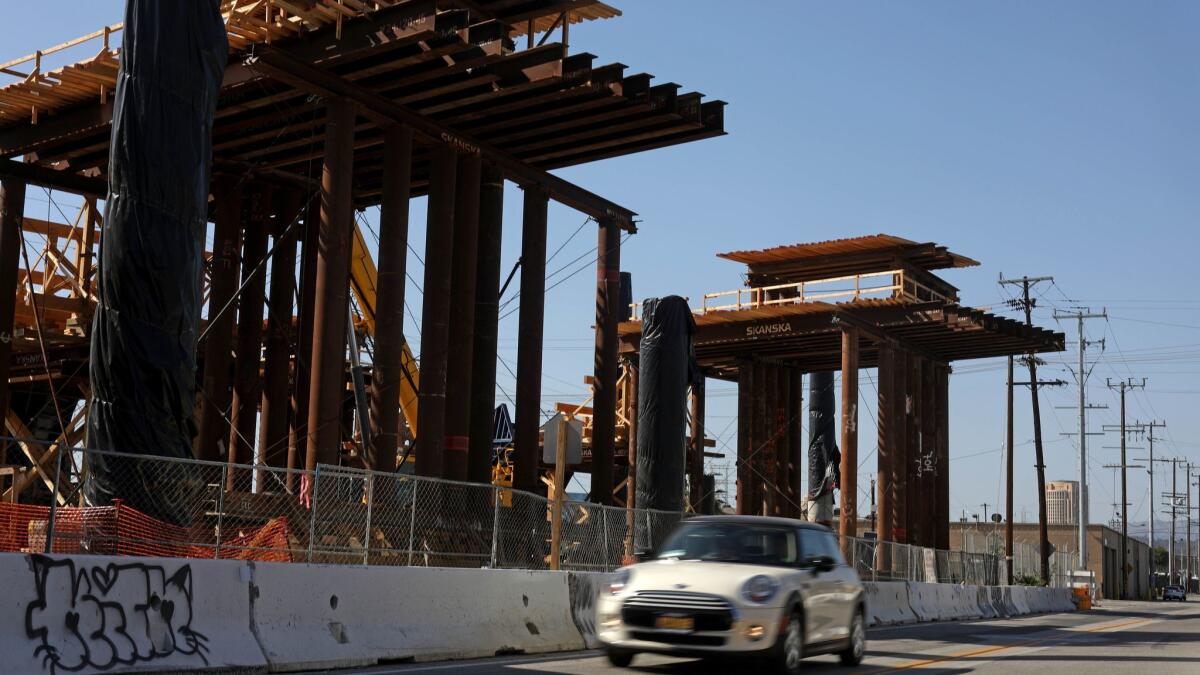Zoning Boyle Heights: What an ‘innovation district’ could mean for the neighborhood

- Share via
The city of Los Angeles is in the middle of a multi-year process to rewrite its zoning code. Among the neighborhoods that are in the process of having that code retooled: Boyle Heights. City planners have been staging meetings around the neighborhood to develop the plan, which is expected to go into effect in 2019.
The plan will affect residential building and bring a new “Innovation District” to the neighborhood at a time when Boyle Heights has been contending with anti-gentrification protests.
For the record:
3:30 a.m. Aug. 12, 2018This story states that Jason Gallegos serves as chair of the Boyle Heights Neighborhood Council’s Planning & Land Use Committee. He has since left that post and has been replaced by Rafael Chagoya.
As with similar plans for other parts of Los Angeles, the Boyle Heights Community Plan calls for higher-density building along transit corridors and changing backyard setbacks to help legalize existing apartment units in an effort to alleviate the housing crunch.
According to the Southern California Assn. of Governments, Boyle Heights is predicted to expand by more than 8% in the next two decades, from an estimated 86,000 residents to 93,000. The number of residential units in that same period is expected to grow from 23,000 to 27,000.
The zoning plan will also include strategies for preserving the neighborhood’s intimate commercial corridors — walkable stretches along East 1st Street and Cesar Chavez Avenue that are lined with mom-and-pop businesses.
The idea, says senior city planner Haydee Urita-Lopez, who is overseeing the update on the Boyle Heights plan, is to prevent commercial strips from turning into dull rows of big box chains that push out out small family businesses.
“We have frontages, massing standards, things that are important to the character of the area,” she says. “These are things that help mimic existing patterns of development. If people hear zoning, they think, ‘I’m getting pushed out.’ But these new zoning codes will codify what is already there.”
Part of the goal, adds principal city planner Craig Weber, “is to get buildings to properly address the street so that we don’t have blank walls and parking lots.”
The section of the plan likely to draw the most scrutiny is devoted to the largely industrial area that borders the Los Angeles River — the area known as the Flats. The area, which is lined with light industrial infrastructure, much of it dating to the early or mid-20th century, has been a draw to art galleries that have occupied some of the old warehouse spaces.
The community plan as it stands has designated the industrial portions of the neighborhood an Innovation District, geared at commercial enterprises as well as light industry, including green businesses and clean technology. This would potentially make the neighborhood part of a biotech corridor that would extend between USC and Cal State Los Angeles.
Urita-Lopez says the idea behind the district is to set aside land that could support employment in the future.
“There is 30% youth in the area,” she notes. “So we want to leave some light industrial while still being open to other industries and manufacturing. We want to plan for the generation of today and of tomorrow.”
But those benefits all depend on the plan’s execution.
“We are still thinking that piece through and investigating what it means,” says Isela Gracian, who heads the East L.A. Community Corp., a nonprofit housing developer. “What jobs does that bring? Biotech can mean so many things.”
A manufacturing plant could bring needed blue-collar jobs, while a research laboratory would be dependent on a more highly skilled, better paid workforce.
The district could be a benefit, Gracian says, if the city works toward making sure that new businesses truly serve the community.
“It can be done if the industries that are recruited can commit to local hiring and have training programs,” she adds. “But that would take coordination with the economic development team” — the city’s Economic & Workforce Development Department, headed by Jan Perry.
Zoning can do only so much. While zoning laws can set general standards, they don’t always have the capacity to tackle the issues faced by a neighborhood at a hyper-local level.
“New zoning codes and affordable housing address the citywide aspects of affordable housing,” says Jason Gallegos, who serves as chair of the Boyle Heights Neighborhood Council’s Planning & Land Use Committee. “But it is found lacking here, in that it doesn’t specify (and by law) cannot target the housing issues specific to Boyle Heights.
“How could we ensure that these new developments have something that ensures that Boyle Heights residents get first dibs? How can you change the percent of low, extremely low area median income to reflect not county or city levels, but local levels within Boyle Heights?”
Those are the issues that planners will be tackling in the months to come.
Sign up for our weekly Essential Arts & Culture newsletter »
carolina.miranda@latimes.com | Twitter: @cmonstah
More to Read
The biggest entertainment stories
Get our big stories about Hollywood, film, television, music, arts, culture and more right in your inbox as soon as they publish.
You may occasionally receive promotional content from the Los Angeles Times.











